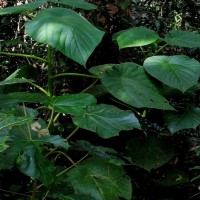Top 10 Plants You Shouldn't Touch
These plants and trees are extremely dangerous and you shouldn't touch them. If you touch them, they can hurt you really bad. They can cause severe pain, itchiness, rashes, blisters, third degree burns or even blindness. Also, do not eat these plants/trees because they're very toxic and they can hurt you a lot, they can also kill you. If you see any of those plants/trees, do not touch them and do not eat them.
Gympie gympie also known as the suicide plant is one of the deadliest plants in the world. Its stinging is extremely painful and it's considered to be the most painful feeling of all time. The hairs of the plant can penetrate through your skin and it will hurt you even more. It can also hurt animals really bad. The pain can last for a very long time, around several months, if not more. Its feeling is like a mix of being electrocuted and being burnt by hot acid at the same time. A cop in Australia mistakenly used a gympie gympie leaf as toilet paper. The pain was so unbearable that the cop shot himself. Gympie Gympie plants are commonly found in rainforests in Australia. If you touch this plant, go to a doctor or get some treatment. If you're not able to do any of these things, use a pair or tweezers or adhesive tape to remove the hairs from your skin.

Poison ivy is a very dangerous plant that are very common to find. Poison ivy can give a lot of rashes, blisters and bubbles if you had contact with the plant. Its sap is very contagious as well. The reaction will start within 12 to 72 hours. If you did touch this plant, wash away the sap as soon as possible to avoid spreading it everywhere. If you find any poison ivy plants at home or somewhere nearby, do not burn it because the poison ivy smoke will hurt you internally if you breathe it. It's better to call an experienced person to remove it. Also, remember this phrase "Leaves of three, let it be."
Poison oak is a relative of poison ivy. It can give you rashes, blisters and even bubbles. If you accidentally touched this plant, wash away the sap as soon as possible. Its sap is also contagious.
I might have touched some. Say inches away for about 30 minutes and didn't notice or get a reaction. I may or may not be immune

They will crush your fingers. Painful
EDIT: Okay, I was ignorant here. They won't crush your fingers, but still.
Predatory plant. Definitely avoid contact with the "mouth".

Giant hogweeds are extremely dangerous plants that can cause you severe pain. Its sap is very toxic and it makes your skin become extremely sensitive. It can cause you 3rd degree burns or even blindness if your skin is exposed to the sun. If you did touch this plant, wash yourself and wash everything that came contact to. Also, do not expose your skin to the sun for at least 48 hours. If you find this plant at home or somewhere nearby, do not touch it, call a professional or an experienced person to remove it. The plant can also grow as high as 14 feet tall. They're commonly found in fields or forests in several countries.

Aside from being poisonous, bees love hiding inside of it.

Stinging nettles are plants that can cause you itchiness and mild pain. The pain won't last very long either unlike some very dangerous plants. These plants are very common and can be found in several countries. If you want to remove these plants, it's best to use working gloves.
1. The picture isn't a stinging nettle. 2. I hate these. If you asked me for something I hate, I would say nettles
Hurts like a stinging bee or touching something very hot.
Cow parsnips are very similar to giant hogweeds and wild parsnips. They're also very painful, but not as much as giant hogweeds. The flowers are also white, but the height of the plant isn't as tall as the giant hogweeds. These plants also contain sap. They're quite similar to the wild parsnips and they can be found in several countries.
Wild parsnips are very similar to giant hogweeds, but a bit less painful. The flowers are yellow instead of white. They also contain sap just like giant hogweeds. They won't grow as tall as the height of the giant hogweeds. If you touched this plant, wash away the sap as soon as possible and do not expose your skin to the sun for at least 48 hours. They're commonly found everywhere in several countries. They can also be found in your backyard. Call a professional to remove these kinds of plants.
Manchineel tree is a dangerous tree that contain deadly fruits. They look like tiny apples, but they're extremely toxic and they can kill you. The tree's sap can cause blisters and even temporary blindness. They're extremely dangerous and you shouldn't touch them.
Poison sumac is also a relative of the poison ivy plant. They all have the same saps and they can hurt you a lot. Wash away the sap if you contacted it.

I've touched one of these before, don't ask me what the hell I was thinking.
Really no one put this on yet? WOW!
Buttercup plants are innocent looking flowers, but they're extremely dangerous. They can poison animals if they eat it. If people eat these flowers, they can die because the buttercup flowers are extremely toxic.

This is just plain common sense.
Very sharp spikes on the sides of the branches, can easily give people infection from prickling their fingers on them.